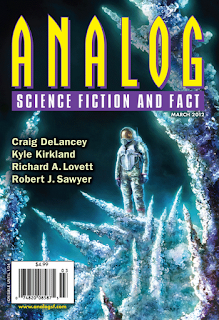Monday, December 26, 2011
Analog Science Fiction and Fact March 2012
A pretty average or slightly over average issue. Most of the stories might have been longer.
"The Ediacarian Machine" by Craig DeLancey
An apparently alien probe is found embedded in ancient rock formation. A woman who found it asks help from a former boyfriend whose company specializes in microrobots. There start to examine to artifact using a virtual reality interface. The artifact is in surprisingly good condition and the power appears to be on, even after a few million years. A pretty nice story, especially the first half. The second half was weaker, but it really would have been hard to follow the setup of the story. The story could have been the first part of a novel. ***½
"Mother's Tattoos" by Richard A. Lovett
Tattoos are being used as a sort of surveillance against terrorism. The people who wield the special tattoos get a monthly stipend, while the tattoos alert officials if the detect traces of explosives or other similar things. The problem is that they are starting to be too sensitive and there are false positives. Also, what constitutes threating behavior…? A pretty good story, another one which was slightly too short. ***+
"Ernesto" by Alec Nevala-Lee
There surprising cases of people getting cured from cancer during the Spanish civil war. Those who have been healed have stayed in a monastery and have had stigmata. An interesting story. There really seems to be some anecdotal evidence for the described method for curing cancer. However, I don’t see how erysipelas could be on all limbs at the same time. Also, before penicillin that would have been very life threatening infection. Not a very science fictional story, but pretty good anyway. Too short. ***+
"Upon Their Backs" by Kyle Kirkland
A some sort of super-secret agent tries to find out the meaning of several naked bodies that are apparently in some sort of suspended animation from a strange cave. At the same time, he has some qualms about his job. Apparently the story happens in some sort of alternative future, where paper is still used for EEG registrations – in our world computerizes systems have been used for almost inclusively almost a decade :-). Somehow I didn’t really get involved in the story – neither the mystery of strange clones nor the battle of the consciousness of the main protagonist. The former wasn’t defined well enough and I couldn’t identify with the main character enough to care about his worries. Maybe a longer form might have served the story giving more background to the characterization and the plot. ***-
Tunnisteet:
Analog review
Subscribe to:
Post Comments (Atom)


No comments:
Post a Comment